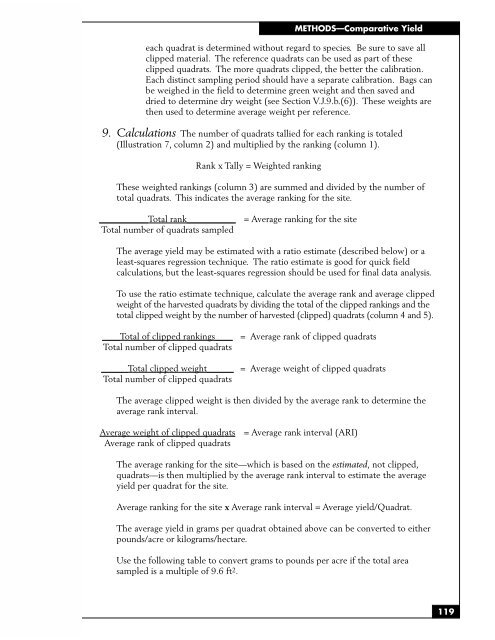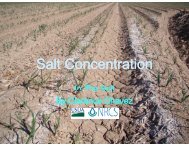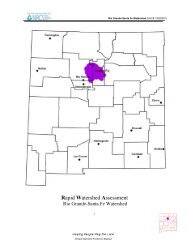SAMPLING VEGETATION ATTRIBUTES - New Mexico NRCS - US ...
SAMPLING VEGETATION ATTRIBUTES - New Mexico NRCS - US ...
SAMPLING VEGETATION ATTRIBUTES - New Mexico NRCS - US ...
You also want an ePaper? Increase the reach of your titles
YUMPU automatically turns print PDFs into web optimized ePapers that Google loves.
METHODS—Comparative Yield<br />
each quadrat is determined without regard to species. Be sure to save all<br />
clipped material. The reference quadrats can be used as part of these<br />
clipped quadrats. The more quadrats clipped, the better the calibration.<br />
Each distinct sampling period should have a separate calibration. Bags can<br />
be weighed in the field to determine green weight and then saved and<br />
dried to determine dry weight (see Section V.J.9.b.(6)). These weights are<br />
then used to determine average weight per reference.<br />
9. Calculations The number of quadrats tallied for each ranking is totaled<br />
(Illustration 7, column 2) and multiplied by the ranking (column 1).<br />
Rank x Tally = Weighted ranking<br />
These weighted rankings (column 3) are summed and divided by the number of<br />
total quadrats. This indicates the average ranking for the site.<br />
___________Total rank___________ = Average ranking for the site<br />
Total number of quadrats sampled<br />
The average yield may be estimated with a ratio estimate (described below) or a<br />
least-squares regression technique. The ratio estimate is good for quick field<br />
calculations, but the least-squares regression should be used for final data analysis.<br />
To use the ratio estimate technique, calculate the average rank and average clipped<br />
weight of the harvested quadrats by dividing the total of the clipped rankings and the<br />
total clipped weight by the number of harvested (clipped) quadrats (column 4 and 5).<br />
____Total of clipped rankings____ = Average rank of clipped quadrats<br />
Total number of clipped quadrats<br />
______Total clipped weight______ = Average weight of clipped quadrats<br />
Total number of clipped quadrats<br />
The average clipped weight is then divided by the average rank to determine the<br />
average rank interval.<br />
Average weight of clipped quadrats = Average rank interval (ARI)<br />
Average rank of clipped quadrats<br />
The average ranking for the site—which is based on the estimated, not clipped,<br />
quadrats—is then multiplied by the average rank interval to estimate the average<br />
yield per quadrat for the site.<br />
Average ranking for the site x Average rank interval = Average yield/Quadrat.<br />
The average yield in grams per quadrat obtained above can be converted to either<br />
pounds/acre or kilograms/hectare.<br />
Use the following table to convert grams to pounds per acre if the total area<br />
sampled is a multiple of 9.6 ft 2.<br />
119




